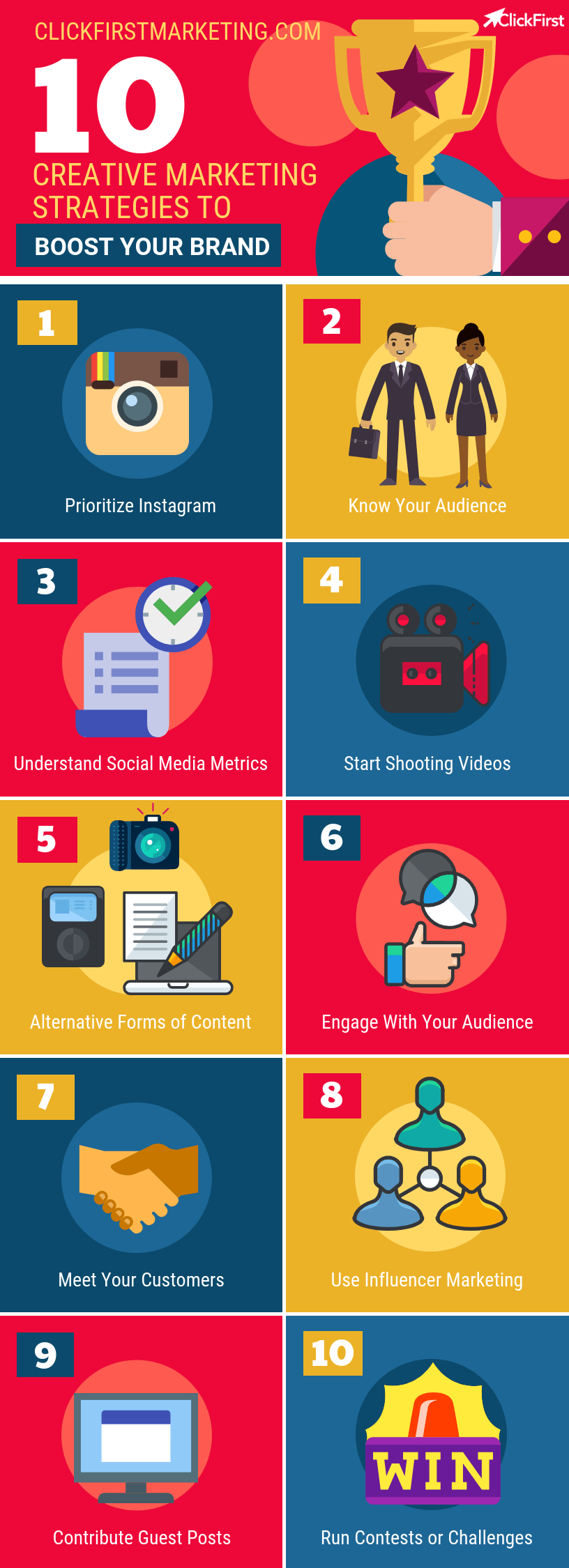Did you know that Google receives 40,000 search queries every second which adds up to 3.5 billion searches per day?
Now, more than ever, a creative marketing strategy is necessary for potential customers to notice your brand online. Customers are looking for brands that they can engage with over shared beliefs and values.
That said marketers need to be careful that their plans don’t harm the brands they are trying to promote. We don’t have to look far to find brands who have pushed the envelope too far with their marketing plans.
Read on to learn about some creative marketing strategies to help your brand increase its visibility in 2018.

Popular and Upcoming Trends in Creative Marketing
People want to buy products from brands they trust. Of course, the step before that is making people aware of your brand. More and more, marketers are finding that the key to a successful relationship between brands and consumers comes down to how a brand is viewed by their target demographic.
1. Prioritize Instagram
Last year, Instagram announced that they had reached 800 million users and that an astounding 500 million use the platform on a daily basis.
Between a rapidly increasing user-base, a shift in demographics and privacy controversies, Instagram has become a more valuable platform than Facebook for many businesses.
Of course, you need to define your target audience and determine if they’re using Instagram before investing heavily in a presence on its platform.
2. Know Your Audience
In other words, marketers need to make a careful analysis of their audience when putting together a creative marketing strategy.
The fact is that even as Instagram is increasing in popularity, some demographics aren’t on it all. Considering that nearly 80% of adults with internet access use Facebook, we’re certainly not advocating ignoring it completely!
Marketers need to understand the demographics of people who are already buying a product or service, as well as, the groups of potential but “harder-to-sell-to” customers.
3. Understand Social Media Metrics
Marketers who are only focusing on vanity metrics like the number of followers or the number of likes on a post are doing themselves a disservice. It’s important to keep in mind how people use social media and that Likes or Follows are not indicative of a lasting relationship.
Instead, marketers need to consider more detailed metrics including reach (the number of unique users who see your post), engagement (the number of interactions divided by the number of times a post is seen) and clicks.
Specifically, make sure you’ve installed conversion tracking when and where you can so that you can determine if your social media (and PPC advertising) leads to actual sales, interactions, etc.
4. Start Shooting Videos
Videos have become one of the most important, if not THE most important tool for marketers. This is especially true for brands that are selling high-value, discretionary items.
Don’t worry if you don’t have the budget for professional video work. There are many immensely successful YouTube channels that show people unboxing and reviewing products. All you need to put together an unboxing video of your own is a tripod and a smartphone.
Also, there are many ways to outsource the creation of videos affordably. And, there are several subscription-based online platforms that are very affordable and easy to use. We like using Animaker for creating whiteboard and animated videos.
5. Alternative Forms of Content
In the same way that there are different learning styles, people also engage differently depending on how content is delivered. Leverage that and think about creating an infographic or podcast.
Infographics are not only more likely to be read compared to articles, they are also more conducive to skim reading. This is what makes them more likely to be shared than long-form content.
Podcasts, additionally, are a great way to position yourself as an expert in your field simply by having experts come and chat with the host about the industry that you’re in. Remember, don’t lecture your listeners! Most people want to listen to podcasts where they feel like the host is having a casual conversation. If you are wondering where to get started with podcasts, check out Podbean.
6. Engage With Your Audience
One of the biggest changes that social media brought to the world of marketing is the ease with which customers can have a conversation with brands.
Use this to your advantage, and engage with your audience. Follow up quickly on comments, and especially on complaints. When you’re replying to users’ comments, offer them helpful information and make sure you don’t just sound like a robot!
There are tools that analyze the best times to post on social media, so use those but also try to post at times when someone from your social team can reply quickly to questions or complaints.
7. Meet Your Customers
Hosting live events is an effective marketing tool for both B2B and B2C businesses. For B2B businesses, these events provide an opportunity for clients to develop more meaningful relationships with the business, for the press to cover the event and for clients to network.
For B2C companies, a fun and memorable event will lead to press coverage, excitement about future events and, most importantly, curiosity about the brand behind the event.
8. Harness the Power of Influencer Marketing
Love it or hate it, influencer marketing, at least for now, is growing. For products geared towards the millennial and Gen X demographics, using influencers to promote your products on social media is essential.
When employing influencers as part of your strategy, it is important to choose ones who present the product in a natural way that is in line with their own personal brand. The key to influencer marketing is that the advertising is subtle and feels authentic.
9. Contribute Guest Posts
We hope that your company already has its own blog that users can find thanks to your efforts in search engine optimization and marketing, however, this is just one method to reach potential customers.
Reach out to influential bloggers in your industry and ask them if you can contribute a guest post to their blog. In this way, you can leverage their audience and hopefully bring them to your site as a result.
10. Run Contests or Challenges
Another great way to engage your users is by offering them an incentive. Set up a challenge or contest with a unique hashtag that requires users to complete a task, or maybe just tag their friends on the post.
This will help you to organically increase your audience and create excitement for the prize. Just a word of caution, make sure that the challenge doesn’t lead to any of the health hazards that have cropped up in recent years.
What’s Next for Creative Marketing?
Predicting the next trends in creative marketing is based on what has happened in the past. Of course, that doesn’t take into account some completely new social media platform jumping into the fray.
One thing is for sure, marketers will be turning more and more to analytics to help determine the success of their campaigns.
Feeling overwhelmed? Find out how ClickFirst can help you with everything from search engine optimization to content creation and marketing.


